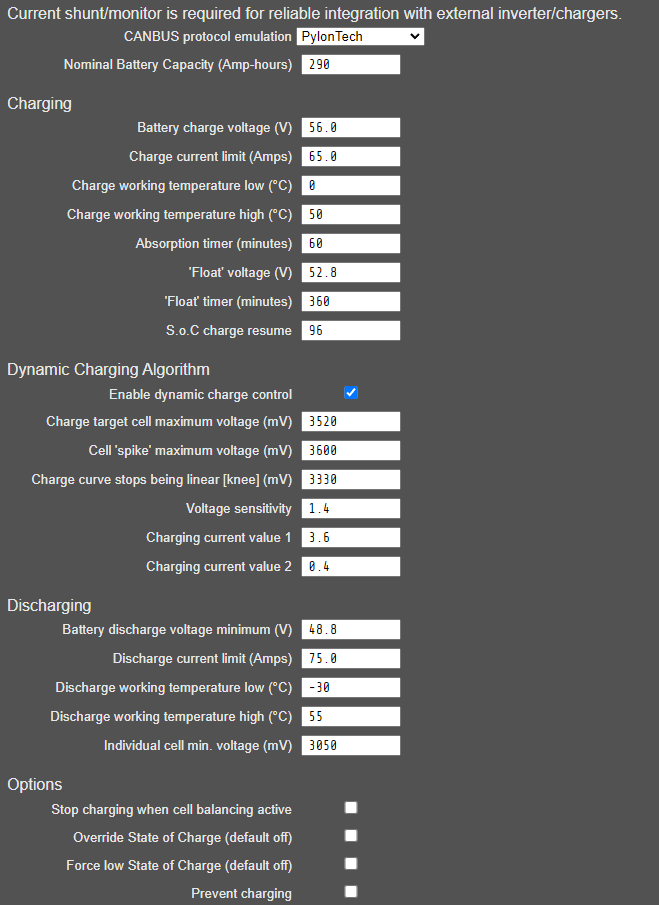Theres some discussion going on about this now over here…
@buddhafragt and @gjones84 if you take a look at this thread charging algorithm - "floating" after Lithium cells are fully charged · Issue #206 · stuartpittaway/diyBMSv4ESP32 · GitHub
DIYBMS will soon have its own absorb*/float*/fully charged modes - its work in progress, but the code is complete if you want to try it. I’m currently running it on my house system, working well.
** I’m aware Lifepo4 doesn’t have absorb/float modes similar to lead acid cells - this is an equivalent to prevent trickle charging lifepo4 at the end of the charge cycle.
I’m trying to understand how the DVCC code is working, still not 100% figured it out.
I should mathlab it on a quiet evening…
I’ve set these parameters:
Battery Charge Voltage = 57,4
Charge target cell maximum voltage = 4100
Cell spike maximum voltage = 4125
Knee voltage = 3950
Voltage sensitivity = 3.0
Charge current value 1 = 10,0
Charge current value 1 = 0,2
All modules start to bypass at 4110
I can’t get the cells fully charged (and balanced) as the CVL is varying between 56.6 - 56.7, so SoC goes up to 90%
The voltage range beween the packs is ~30mV.
What obvoius mistake I’m making?
(My cells are samsung inr21700-33j (Tesla model 3) that’s why 4.1V is choosen)
hi @Bert_Van_Eyken I don’t believe you have made any mistakes - do you also have the DIYBMS current monitor running for SoC calculation?
These are the settings I’m using for my inverter (Sofar ME3000SP) along with EVE 280K cells LIFEPO4.
My cells do charge to 100%, however there is often a difference in voltage between what the inverter “sees” and the corresponding voltage DIYBMS reads/uses.
Therefore, I use 3520mV as the target cell voltage - even though the cells never actually get that high, usually about 3460mV, likewise the “spike” at 3600mV the cells would never actually charge that high, but are still in a “safe” zone.
Assuming you have 14 cells - 57.4V that should be higher, to compensate for the difference between inverter and DIYBMS.
Therefore, I suggest that you slowly increase the charge target cell max voltage (probably in 20mV steps) and also increase the charge voltage by the same amount *14, and then wait for the charge to finish.
Also make sure to set the “Fully charged voltage” and “tail current” in the current monitor page - ideally the fully charged voltage is a little below the battery charge voltage (I use 55.4V in my example)
You can also try lowering the voltage sensitivity, which should make it respond more aggressively.
Hi Stuart, thanks for the work!
I will try it!!
Hi Stuart,
i am currently testing the new allinone board on my victron off grid systems (3x Multiplus 2 5000 / Fronius Symo 20.0 / 16s2p eve lfp 280k cells ). Works great so far!
I would be interested in the new code regarding the absorb/float/fully charged modes.
Maybe you could provide it to me?
Thanks!
BR
Andreas
Sure - its here… Keep history of which cell is lowest/highest · stuartpittaway/diyBMSv4ESP32@60b2c12 · GitHub
Look at the bottom of the page DIYBMS-Release-Artifact-2023-08-30-13-35
thank you, i have tried it. Unfortunately the controller cannot connect to the allinone board with this version (packets received is always 0)
i have already found the problem… the communication speed in the settings menu had to be set to 10K again. ![]()
